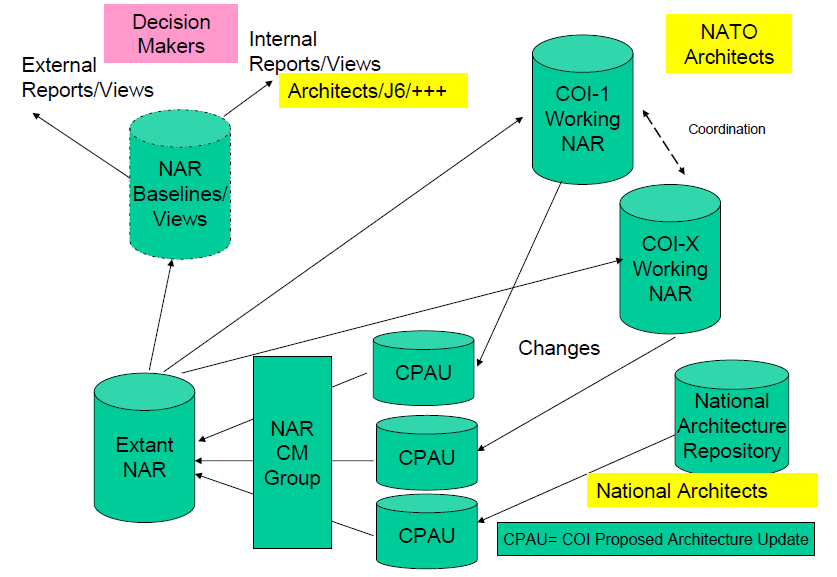Nato Architecture Framework (NAF) - 5 - Architecture Management
Jump to navigation
Jump to search
How to make change。
- RFCPs may be submitted online or via mail
- RFCPs may be initiated by any organisation using the NAF v3
- Expert (i.e. individual) level
- National level
Architecture Management Development。
Sponsors of NATO architectures are responsible for ensuring that activities conform to the NAF v3, and in particular the NMM and the ADEM, and for the maintenance of CM over the resulting architectural products:
- the NC3B for the Overarching Architecture
- ACT for Reference Architectures (RA)
- Host Nations for Target Architectures (TA))
NAR。
NAR Configuration Management Process。
The NAR CM process operates in accordance with the following principles:
- At any particular moment in time, the extant version of the NAR-content will be available for use by all Communities Of Interest (CoI) either in the form of:
- the underlying model, or
- standard NAF views and subviews extracted from the model
- The CM of the NAR (as a composite federated repository holding architectural information on more than one architecture) will be the responsibility of the NC3A under the direction of the C3 PWG
- The NC3A may establish a NAR CM Group of interested parties to support CM
- The NAR CM activity will be funded proportionately by the sponsors of the architecture development: (use of the NAR will significantly reduce architectural development costs and the need for individual architecture CM activity and hence the synergy achieved will reduce overall costs).
- The NC3A will be responsible for ensuring that all their architectural products are integrated into the NAR and that the content of the NAR is used as the expanding basis for future work
- For example, where a TA is required to support a project within a programme for which a CP RA is available, the project team would first take a copy of the extant NAR content and develop it to provide the required detail for the TA
- Further development of the CoI proposals in the form of CoI Proposed Architectural Updates (CPAU) need to be reviewed by the NAR CM authority and the NAR CM Group as appropriate, to ensure deconfliction
- Where NATO sponsors require architectures to be developed by organisations other than the NC3A, the implementing organisation should use the extant NAR content as the baseline, and work with the NC3A to agree the appropriate methodology of integration using the process as described above: in cases of dispute, the C3 PWG (Policy Working Group) will provide the first level of arbitration
- A similar procedure should be adopted by Nations wishing to share National architectural information with NATO via the NAR.
Architecture Management。
Ensuring that:
- maintainable architecture products are developed;
- architecture products are consistent, coherent, complete, accurate, current, and accessible to authorized parties
- architecture products are developed according to standards (i.e. according to the NAF, and by implication the NMM;
- controls are in place that prevent, detect and correct undesired events related to the development, use and maintenance of architecture products;
- an operational and maintainable tool environment is in place and is used for the development, use and maintenance of architecture products;
Architecture Management Tenets。
- Architecture should be managed centrally
- There should be only one authority controlling architecture development for NATO
- The guidelines for architecture management are illustrative, but not prescriptive nor are exhaustive
- Roles and their responsibilities, involved in architecture management are described in a generic manner, and are not assigned to named persons or departments
- The establishment of such assignments will be vested in the NATO Interoperability Policy (NIP) and/or the NATO Interoperability Directive (NID)
Source of NAF Architecture Management prescriptions。
- IT Governance Institute’s Control Objectives for Information and related Technology (CobiT v4.0)
- OGC (ITIL 2) and Projects in a Controlled Environment (Prince 2)
- Software Engineering Institute’s Capability Maturity Model (CMM)
- International Standards Organisation’s standards on Systems engineering & System Life-cycle Processes (ISO 15288) and Information Security Governance (ISO 17799)
Architecture Management Elements。
- Architecture Strategy Plan
- Architecture Quality System
- Architecture Repository
- Architecture Infrastructure
- Architecture Process Structure
- Architecture Standards Structure
- Architecture Certification Structure
- Architecture Change Management System
- Architecture Configuration Management System
Architecture Strategy Plan (ASP)。
- Manages and directs all architecture related investment in line with operational strategies and objectives

